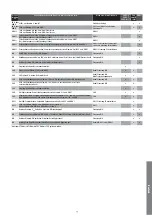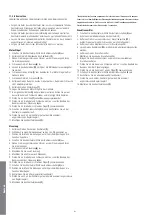
45
11.2 Replacement of components
Always apply the valid safety regulations and instructions.
• Make sure that [parts of] the fan not [yet] anchored and tools cannot
fall/blow off the roof or cause damage or personal injury in any other
manner.
• When the ventilator is completely or partly dismantled, make sure nobody
can touch rotating parts or parts under current.
• Do not leave a [partly] dismantled fan which is connected to the power
supply, unattended.
• Make sure that parts which conduct current do not become wet.
Motor impeller
1. Turn off the fan using the service isolator
[4]
.
2. Remove the fan cover
[2]
.
3. Pull the connected switches out of the controls and remove the earth wires.
4. Unscrew the controls
[6]
.
5. Undo the retaining brace
[10]
with which the motor wires are bound up.
6. Unscrew the motor
[7]
from the frame. The motor impeller may be left to
lie in the housing.
7. Unscrew the 4 bolts
[9]
.
8. Remove the frame. Take care not to damage any wires or hoses.
9. Remove the motor impeller
[7]
.
10.Lay the new motor impeller in the housing.
11.Put everything back in the reverse order. Take care that cables and hoses
are put back in the right place.
12.Check that the impeller
[7]
can rotate freely.
13.Check that the cables and hoses are not lying against sharp edges of
the frame or the controls.
14.Make sure the cables cannot come in contact with the impeller
[7]
.
15.Turn the fan back on using the service isolator
[4]
and check whether
it works properly.
16.Also check whether the fan reacts properly to the regulator[s], if fitted.
17.Fix the fan cover back in place
[2]
.
Controls
1. Remove the fan cover
[2]
.
2. Connect a VU manual unit onto the sub D9 connector.
3. Select ‘Save/set’ then ‘Save’ in the ‘Settings’ menu.*
4. Turn off the fan using the service isolator
[4]
.
5. Pull the connected switches out of the controls and remove the earth wires.
6. Unscrew the controls
[6]
.
7. Install the new controls.
8. Attach all plugs and earth wires.
9. Check that the cables and hoses are not lying against sharp edges of the
frame or the controls.
10.Make sure the cables cannot come in contact with the impeller
[7]
.
11.Switch on the fan using the operating switch
[4]
.
12.Select ‘Save/set’ then ‘Set’ in the ‘Settings’ menu.
13.Check whether everything works properly.
14.Also check whether the fan reacts properly to the regulator[s], if fitted.
15.Fix the fan cover back in place
[2]
.
*Does this function no longer work due to the defect? Make use of the infor-
mation on the sticker on the controls for point 12. Or that of a comparable fan.
Or set point 12 in accordance with the settings list or the table in §9.1.
Pressure transmitter
1. Turn off the fan using the service isolator
[4]
.
2. Remove the fan cover
[2]
.
3. Remove hose connections on the pressure transmitter
[12]
. Take note of
where the hoses belong.
4. Remove the electrical connection in the pressure transmitter.
5. Undo the retaining brace
[10]
with which the wires are bound up.
6. Remove the pressure transmitter.
7. Install the new pressure transmitter.
8. Re-attach the electrical connection and hose to the pressure transmitter.
9. Check that the cables and hoses are not lying against sharp edges of the
frame or the controls.
10.Make sure the cables cannot come in contact with the impeller
[7]
.
11.Switch on the fan using the operating switch
[4]
.
12.Check whether everything works properly.
13.Also check whether the fan reacts properly to the regulator[s], if fitted.
14.Fix the fan cover back in place
[2]
.
english
















































